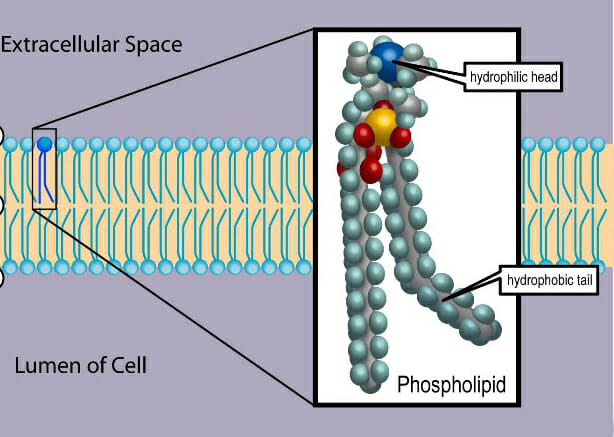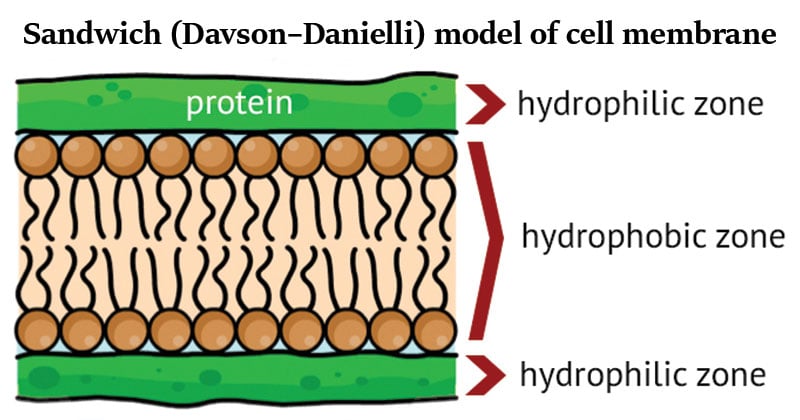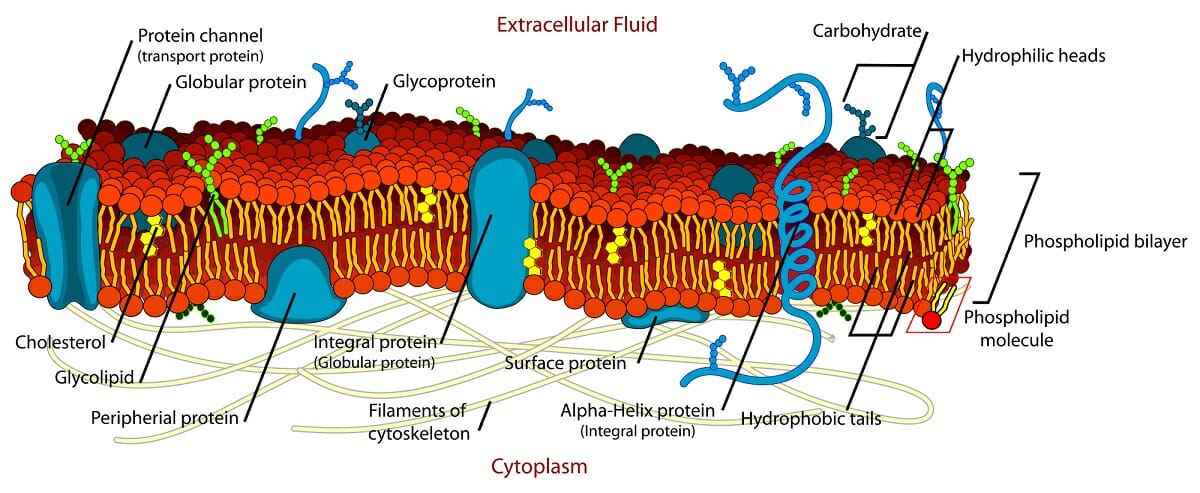Fluid Mosaic Model Describes the Plasma Membrane as Consisting of
We identified it from honorable source. Plasma membranes range from 5 -10 nm in thickness.

Fluid Mosaic Model Cell Membranes Article Article Khan Academy
10 The fluid mosaic model describes the plasma membrane as consisting of A carbohydrates and phospholipids that can drift in the membrane.

. The fluid mosaic model describes the structure of the plasma membrane as a mosaic of components including phospholipids cholesterol proteins and carbohydratesthat gives the membrane a fluid character. B two layers of phospholipids with cholesterol sandwiched between them. Components of plasma membranes are.
The plasma membrane may be known as a fluid mosaic model where the membrane is a fluid structure with various proteins. Chapter5 Quiz Fall 2014 1 The fluid mosaic model describes the plasma membrane as consisting of A a phospholipid bilayer with embedded carbohydrates. Describe the fluid-mosaic model of a plasma membrane.
Diverse proteins embedded in a phospholipid bilayer. The mosaic model of membrane structure describes the structure of the plasma membrane as a mosaic of components including phospholipids proteins carbohydrates cholesterol and proteins that gives the membrane a fluid character. The fluid mosaic model describes the structure of the plasma membrane as a.
Each phospholipid has a hydrophilic head pointing outside and a. According to the fluid mosaic model our cell membrane is a double membrane of phospho lipid molecules. Here are a number of highest rated Cell Membrane Fluid Mosaic Model pictures on internet.
Diverse proteins embedded in a phospholipid bilayer. Singer and Garth L. Carbohydrates and phospholipids that can drift in the membrane.
The fluid mosaic model explains various observations regarding the structure of functional cell membranesAccording to this biological model there is a lipid bilayer two molecules thick layer consisting primarily of amphipathic phospholipids in which protein molecules are embedded. This model explains the structure of the plasma membrane of animal cells as a mosaic of components such as phospholipids proteins cholesterol and carbohydrates. B two layers of phospholipids with protein sandwiched between them.
Carbohydrates and phospholipids that can drift in the membrane. Question 13 the fluid mosaic model describes the. Two layers of phospholipids with cholesterol.
For comparison human red blood cells visible via light microscopy are approximately 8 µm. The fluid mosaic model was proposed by SJ. Cell membrane overview and.
The fluid mosaic model describes the structure of the plasma membrane as a mosaic of components including phospholipids cholesterol proteins and carbohydratesthat gives the membrane a fluid character. These components give a fluid character to the membranes. D diverse proteins embedded in a phospholipid bilayer.
Cholesterol is also an important compone of this membrane. The fluid mosaic model describes the structure of the plasma membrane as a mosaic of componentsincluding phospholipids cholesterol proteins and carbohydratesthat gives the membrane a fluid character. Carbohydrates and phospholipids that can drift in the membrane.
Proteins are embedded in this layer. Discuss the role of the membrane in the movement of materials through it by each of the following processes. Question 13 The fluid mosaic model describes the plasma membrane as consisting of diverse proteins embedded in a phospholipid bilayer.
Singer and Garth L. The fluid mosaic model describes the plasma membrane as consisting of A a phospholipid bilayer with embedded carbohydrates. Plasma membranes range from 5 to 10 nm in thickness.
Two layers of phospholipids with cholesterol sandwiched between them. A phospholipid bilayer with embedded carbohydrates. Plasma membranes range from 5 to 10 nm in thickness.
The fluid mosaic model describes the plasma membrane as consisting of. The fluid mosaic model describes the structure of the plasma membrane as a mosaic of components including phospholipids cholesterol proteins and carbohydratesthat gives the membrane a fluid character. The plasma membrane is a semi permeable barrier that separates the inside of the cell from the outside environment.
D carbohydrates proteins and phospholipids that can drift in the membrane. We undertake this nice of Cell Membrane Fluid Mosaic Model graphic could possibly be the most trending topic afterward we portion it in google help or facebook. Diverse proteins embedded in a phospholipid bilayer.
C diverse proteins embedded in a phospholipid bilayer. B two layers of phospholipids with cholesterol sandwiched between them. Plasma membranes range from 5 to 10 nm in thickness.
The fluid mosaic model describes the plasma membrane as consisting of a. A phospholipid bilayer with embedded carbohydrates. Plasma membranes range from 5 to 10 nm in thickness.
These components give a fluid character to the membranes. For comparison human red blood cells visible via light microscopy are approximately 8 µm wide. The fluid mosaic model describes the plasma membrane consisting of A Diverse proteins embedded in a phospholipid bilayer B Carbohydrates and phospholipids that can drift in and out of the membrane 2 layers of phospholipids with cholesterol sandwiched betweenthem like an С oreo D A phospholipid bilayer with prokaryotes embedded.
A phospholipid bilayer with embedded carbohydrates b. Two layers of phospholipids with cholesterol sandwiched between them. The fluid mosaic model was proposed by SJ.
The proportions of proteins lipids and carbohydrates in the plasma membrane are different. C carbohydrates and phospholipids that can drift in the membrane. Fluid mosaic model is one of the models which explains the structure of functional cell membrane.
This model explains the structure of the plasma membrane of animal cells as a mosaic of components such as phospholipids proteins cholesterol and carbohydrates. The fluid mosaic model described the plasma membrane that. The plasma membrane is made up of carbohydrates cholesterol proteins and a lipid bilayer or double layer of lipids.
C a protein bilayer with embedded phospholipids. Two layers of phospholipids with cholesterol sandwiched between them. The fluid mosaic model describes the plasma membrane as consisting of The fluid mosaic model describes the plasma membrane as consisting of a phospholipid bilayer with embedded carbohydrates.
View the full answer. The fluid mosaic model is a model of the cell membrane. Its submitted by executive in the best field.
Cell Membranes And The Fluid Mosaic Model Boundless Anatomy And Physiology

Fluid Mosaic Model Cell Membranes Article Article Khan Academy
Why Is The Cell Surface Membrane Described As Fluid Mosaic Quora

Cell Membranes And The Fluid Mosaic Model Boundless Anatomy And Physiology

Fluid Mosaic Model Of Cell Membranes Cell Membrane Lesson Cell Membrane Structure Cell Membrane

In Fluid Mosaic Model Of Plasma Membrane

Fluid Mosaic Model Definition Explanation Quiz Biology Dictionary

Fluid Mosaic Model Cell Membranes Article Article Khan Academy

Sandwich Davson Danielli Model Of Cell Membrane

Fluid Mosaic Model Definition Explanation Quiz Biology Dictionary

Why Is The Cell Surface Membrane Described As Fluid Mosaic Quora

Cell Membrane Definition Structure Function And Biology

The Fluid Mosaic Model Cell Biology Science Systems Biology Biology Lessons

Cell Membranes And The Fluid Mosaic Model Boundless Anatomy And Physiology

Biology Online Journal The Fluid Mosaic Model Of A Cell Membrane Cell Membrane Biology Online Cell Membrane Structure
Cell Membranes And The Fluid Mosaic Model Boundless Anatomy And Physiology

Fluid Mosaic Model Diagram The Fluid Mosaic Model Of The Cell Plasma Membrane For Cell Membrane Coloring Worksheet Cell Membrane Structure Plasma Membrane

Mitochondria Functions Mitochondria Cellular Respiration Cell Model

Comments
Post a Comment